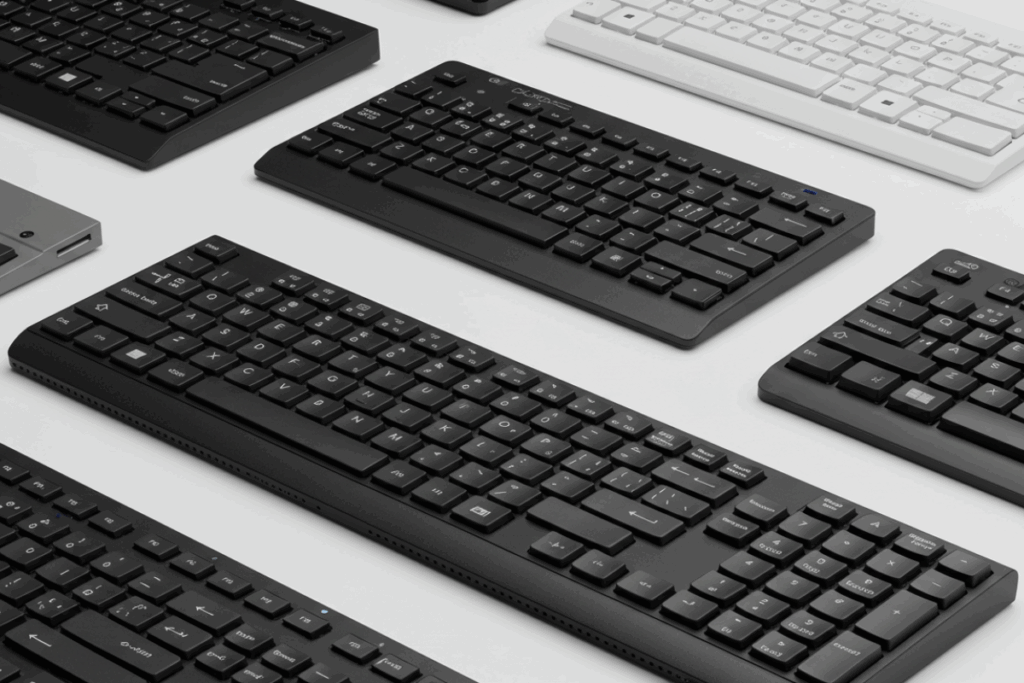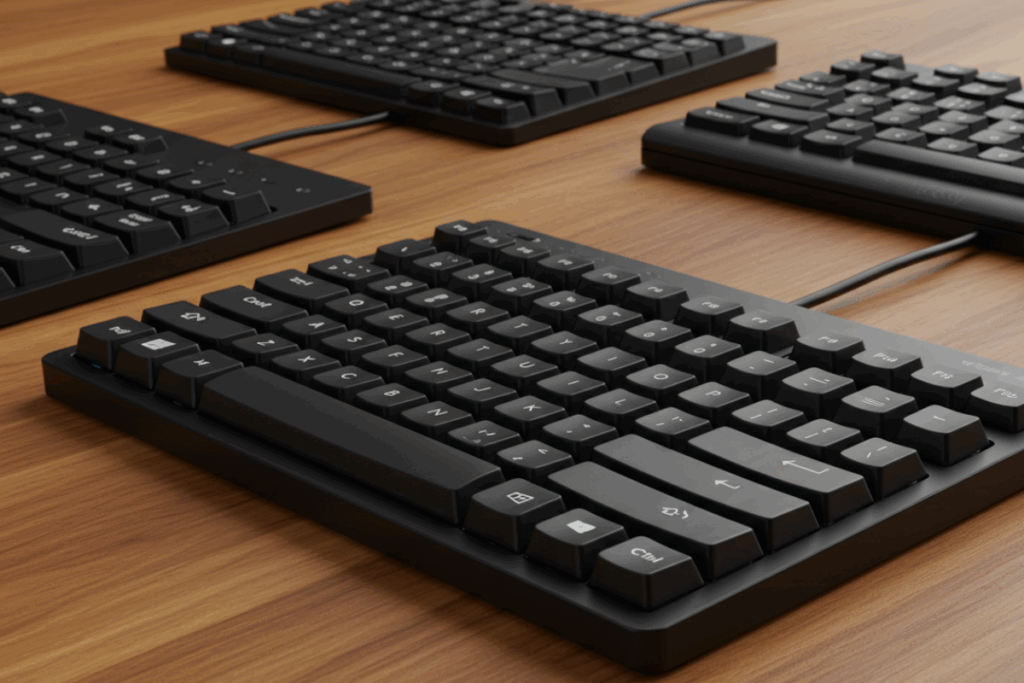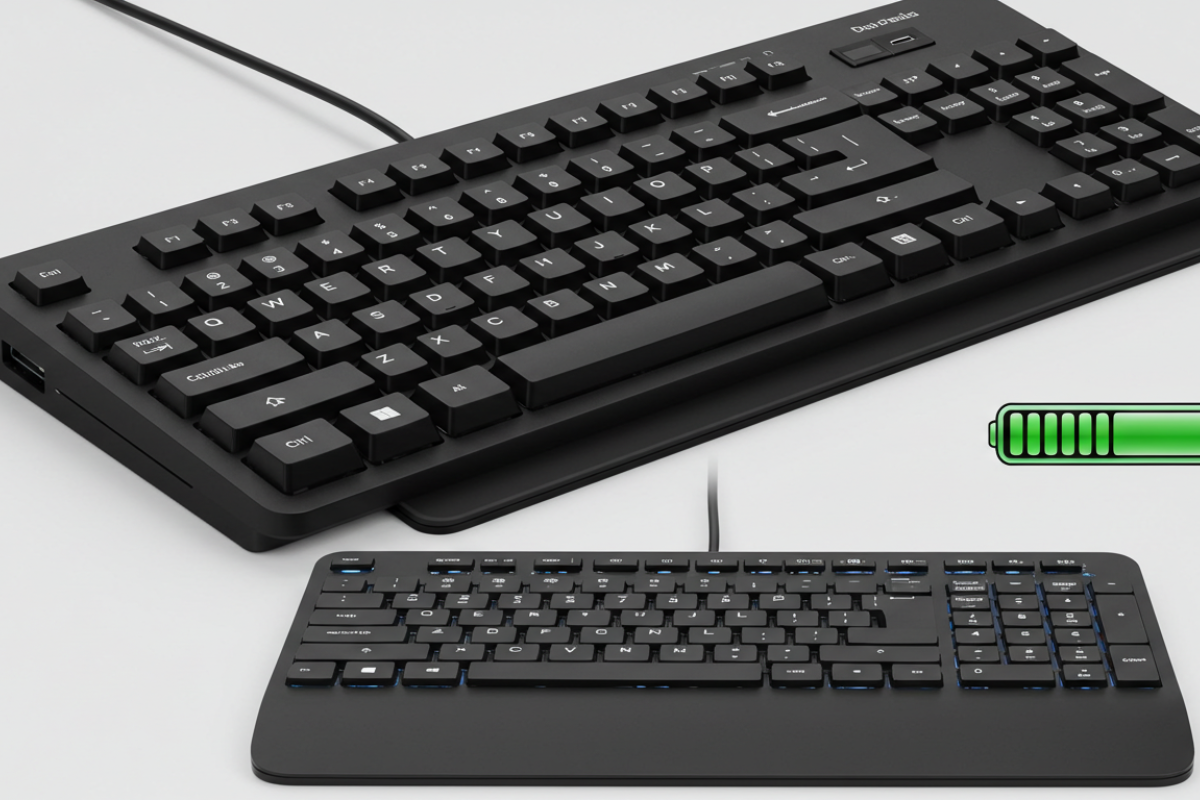Keyboards with long battery life are my focus at Keyboards Technology. Below I share my top picks, how I judge them, and how I define long battery life so you can compare hours, days, or months of real use. I cover the main types — Bluetooth, RF dongles, solar, and rechargeable — and the difference between mechanical and membrane.
I call out the biggest drains like backlighting, RGB, polling rate, and connectivity, and I preview my evaluation criteria: real-world battery endurance, charging method, feature trade-offs, build quality, and price to value. If you travel, work from home, game, or hate charging, these clear picks and simple tips help you spend less time plugging in and more time typing.
Key takeaway
- Trusted picks from Keyboards Technology for keyboards with long battery life.
- Expect days to weeks of use before charging, depending on settings.
- Comfortable typing with low power use is possible.
- Easy setup and clear battery info matter.
- Pick the connection and settings that match your routine to maximize life.
How I explain battery life and measurements for keyboards with long battery life
Manufacturer claims versus real-world hours, days, and mAh
Manufacturers often quote battery life under ideal conditions (low brightness, light typing, long sleep). Those numbers are useful but not promises.
I test keyboards the way I use them: with backlighting on, multiple-device pairing, and real typing sessions. Firmware wake-ups and polling behavior matter — some keyboards wake more often and burn more power.
A quick rule: convert mAh to estimated hours using average current draw. For example, 500 mAh / 10 mA ≈ 50 hours. Averages change with lights and activity, so treat claimed hours as best-case and my tests as likely outcomes.
Important factors I check:
- Backlight: RGB is a big power sink.
- Wireless mode: Bluetooth Low Energy often outlasts 2.4 GHz dongles.
- Polling & firmware: Frequent wake-ups shorten life.
- Usage pattern: Short bursts vs. long sessions change the math.
When comparing models I weight measured hours over marketing copy. Real test conditions matter when choosing keyboards with long battery life.
Typical battery life ranges for different keyboard types and use cases
Grouping boards by use sets expectations:
- Low-power Bluetooth office boards: weeks to months (light typists, lights off).
- Compact Bluetooth boards without RGB: 1–6 months for moderate use.
- Rechargeable mechanical with modest LEDs: 2–8 weeks under heavy use.
- Full RGB mechanical gaming keyboards: 1–7 days with bright animated effects.
- Battery-powered wireless with AA/AAA: months to years depending on cells and use.
Real example: a compact Bluetooth board with a 400 mAh battery lasted ~2 months with backlight off, ~2 weeks with medium RGB — a strong reminder to turn off fancy lighting when traveling.
Rough current draws for quick math (approximate):
- Idle Bluetooth: 1–5 mA
- Active typing (no lights): 5–20 mA
- LED / RGB on: 20–200 mA depending on brightness/effects
I always add a safety margin when estimating from mAh.
Quick metric cheat sheet
| What to compare | What I look for | How I read it |
|---|---|---|
| Claimed hours/days | Test conditions listed? | If no conditions, treat as best-case |
| mAh rating | Convert to hours using estimated mA draw | Example: 500 mAh / 10 mA ≈ 50 hours |
| Lighting | Type and brightness | RGB = big hit. Single LED = small hit |
| Wireless mode | BLE vs 2.4 GHz | BLE usually wins for standby |
| User habits | Typing style, macros, multi-host | Heavy macros and multi-host reduce time |
I use this every time I shop for keyboards with long battery life.
Types of keyboards and battery traits for top wireless keyboards for battery life
Bluetooth Low Energy, RF dongles, wired — how each affects battery life
Here’s how each connection type affects battery life and daily use:
| Connection | How it uses power | Typical battery impact | Pros | Cons |
|---|---|---|---|---|
| Bluetooth Low Energy (BLE) | Low-power radios, sleeps when idle | Best for long life on small batteries | Great for laptops, multi-device pairing, lightweight | May lag for some games or old devices |
| RF dongle (2.4 GHz) | Constant low-latency link via USB receiver | Very good; drains faster than BLE but still long | Very responsive, low input lag, good range | Needs a dongle; can use more power in some modes |
| Wired | No battery needed | No battery — plug and play | Zero charging, stable power, lowest latency | No mobility; cable clutter |
If you want the best keyboards with long battery life, choose Bluetooth Low Energy or an efficient RF dongle model. I’ve used BLE keyboards that lasted weeks on a single charge.
Best low-power keyboards for laptops and portable use
For travel and laptops I look for:
- Connection: Prefer Bluetooth Low Energy for fewer dongles and multi-device use.
- Size & weight: Compact, slim keyboards save space and battery.
- Key switch type: Low-travel switches or scissor keys often pair well with low power.
- Backlight: Turn it off or use low settings — the biggest battery hog.
- Power modes: Auto-sleep and quick wake are musts.
- Battery type: Rechargeable lithium cells for convenience; AA/AAA for quick swaps in the field.
A compact BLE board from Keyboards Technology once lasted over a week of light travel use on a single charge — reliable performance when outlets are scarce.
Which keyboard type fits my daily needs?
- Long emails, low fuss: Bluetooth LE, slim layout, no backlight.
- Competitive gaming: RF dongle, mechanical switches, wired backup.
- Move between phone, tablet, laptop: Bluetooth LE with multi-pairing.
- Desk work, hate charging: Wired or large-battery wireless with minimal backlight.
Key factors that drain or extend battery life on energy-efficient keyboards
I test many wireless models and focus on what truly affects battery life. For keyboards with long battery life, prioritize lighting, connection, and setup.
Backlighting, RGB, and per-key effects versus battery drain
Backlight is the fastest way to drain a battery. Per-key RGB uses extra power because each LED draws current. Turning lights down or off is the single biggest jump in uptime.
| Lighting mode | Relative battery use | Typical use case |
|---|---|---|
| Off | Low | Long sessions, travel |
| Static single color | Low–Medium | Typing in dim rooms |
| Breathing / simple effects | Medium | Casual use with style |
| Full per-key RGB | High | Gaming, showy setups |
I choose the lowest lighting level that still lets me see keys. For work: off or dim single color. For streaming/gaming: accept more drain and schedule charging.
Connectivity, polling rate, and switch type impact on endurance
How a keyboard talks to your device matters. Bluetooth usually uses less power than a dedicated dongle or constant USB. High polling rate increases responsiveness but draws more power — lower it for typing, raise it for gaming.
Switches affect feel more than battery, but per-key LEDs and extra controllers add drain. A quiet membrane board with no lights will last far longer than a fully lit mechanical rig.
Key comparison points:
- Connection: Bluetooth for battery life; dongle for lower latency.
- Polling rate: Lower for typing, higher for competitive play.
- Switch & extras: Lights and controllers add drain.
Simple settings I change to save power
- Turn off backlight in daylight.
- Use Bluetooth profile instead of dongle for long sessions.
- Set a short sleep timeout (30–60 seconds).
- Reduce polling rate to 125 Hz for typing.
- Disable per-key effects; keep static color if needed.
- Use firmware low-power modes if available.
- Carry a small charger or spare batteries for long travel.
A small shift (BLE lights off) once cut my charging routine from every two days to once a week.

How I test keyboards with long battery life and pick the best ones
My standardized test scenarios, measurement protocol, and cycle averaging
I test consistently so results are comparable.
Three scenarios:
- Idle: Paired, no keys pressed, backlight off.
- Typing: Continuous typing at ~40 WPM with mixed keys.
- Active: Media playback and backlight on medium.
I record run time to the low-battery alert, use a timer, and log start/stop times in a spreadsheet. Tests are on the same computer and distance to receiver.
Variables I keep fixed:
| Variable | Value |
|---|---|
| Wireless mode | Bluetooth or 2.4 GHz (same for each run) |
| Backlight | Off / Medium / High (set per scenario) |
| Typing speed | ~40 WPM (consistent sample text) |
| Distance to host | 1.5 meters |
| Number of runs | 3–5 cycles per scenario |
For cycle averaging I run each scenario at least three times. If five runs, I drop highest and lowest and average the rest. I report that as the tested average to reduce fluke results.
Comparing manufacturer claims to tested results
Manufacturers quote ideal conditions. I check:
- What conditions were used for that claim?
- Did they test daily typing or only idle?
- Are batteries replaceable or built-in?
I favor keyboards that match claims under real tests and remain usable past the first year. My top picks are models that repeatedly pass my tests while still feeling great to type on.
What I compare and why it matters:
| What I compare | Why it matters |
|---|---|
| Manufacturer claim | Sets expectations |
| My tested average | Real-world performance |
| Battery type | Long-term cost and swaps |
| Sleep and polling settings | Big impact on life |
| User experience | Battery only matters if keyboard works well |
Reporting format I use for reviews
Each review has the same sections for easy comparison:
- Headline summary — short verdict with battery take.
- Quick stats table — battery type, tested average, wireless mode.
- Test conditions — exact settings used.
- Real-world notes — how it felt after weeks.
- Claim vs Tested — short callout comparing numbers.
- Verdict — who should buy and why.
Typical top-of-review table:
| Field | Example entry |
|---|---|
| Brand | Keyboards Technology pick |
| Model | Model name |
| Battery type | AA / AAA / Rechargeable |
| Tested average | X hours (from cycles) |
| Modes tested | Bluetooth / 2.4 GHz |
| Notes | Backlight used, typing pattern |
I note how many cycles I ran and whether life was inconsistent.
My top recommendations by user type for long battery life
Office, travel, and best portable keyboards with long battery life
For office: slim boards with steady connection and long battery life. For travel: light, foldable, and ready after long flights. For portable use: low weight and battery that lasts a week of meetings.
What I want:
- Stable Bluetooth (multi-device pairing).
- Rechargeable battery with fast charge.
- Low-power switches or scissor keys for long uptime.
Quick feature table:
| Use case | What I want | Why it matters |
|---|---|---|
| Office | Slim layout, strong Bluetooth, backlight optional | Keeps desk tidy; battery lasts workdays |
| Travel | Foldable/compact, light, durable case | Fits bag and stays powered on trips |
| Portable | Bluetooth multi-pairing, long sleep life, quick charge | Move between locations and be ready |
A compact Keyboards Technology model once lasted a week on one charge during a trip — no outlets needed.
Gamers, ergonomic users, and budget shoppers — what to choose
- Gamers: wireless mechanical with good firmware and power modes; trade-off is higher price/weight.
- Ergonomic users: split or curved layouts that are efficient and still conserve battery.
- Budget shoppers: simple Bluetooth boards that outlast cheap membrane models.
Trade-off table:
| User type | Priority feature | Trade-off |
|---|---|---|
| Gamers | Low latency wireless long standby | Heavier or pricier |
| Ergonomic | Split layout efficient power | Learning curve |
| Budget | Simple Bluetooth, good battery | Fewer extras (RGB, hot-swap) |
A budget board I tested delivered long life due to basic backlighting and strong sleep mode — no bells, but it lasted.
Quick buyer checklist for rechargeable keyboards with long battery life
- Battery type: Rechargeable Li-ion is common.
- Real battery life: Look for standby and active hours.
- Power modes: Auto-sleep and quick-wake are huge.
- Connectivity: Multi-device Bluetooth or USB-C option.
- Build: Lightweight for travel; solid for desk use.
- Warranty & support: Good brand support matters.
Feature table:
| Feature | Why I care |
|---|---|
| Auto-sleep | Saves charge when idle |
| USB-C charging | Fast, common cable |
| Multi-device pairing | Switch devices without re-pairing |
| Backlight control | Turn off to save power |
| Firmware updates | Keeps wireless stable and efficient |
This checklist helps me pick true keyboards with long battery life that fit my routine.
Battery care, charging, and maintenance for best mechanical keyboards with extended battery life
Replaceable AA/AAA versus built-in rechargeable, charge times and ports
Choose based on use:
| Type | Typical runtime | Charging / Replacement | Charge time / swap | Common ports | Pros | Cons |
|---|---|---|---|---|---|---|
| Replaceable AA/AAA | Weeks to months (light use) | Swap batteries or use NiMH rechargeables | Swap instantly; NiMH recharge externally 2–8 hrs | None on keyboard | Easy field swap; quick recovery | Bulkier; more waste if disposable |
| Built-in rechargeable (Li-ion) | 20–200 hours depending on mAh & features | Charge via cable (USB-C or micro-USB) | 30 min–6 hrs depending on battery and fast-charge | USB-C most common | Slim design; fewer spares needed | Dead battery means charging or dock required |
Notes:
- USB-C charges faster and is preferable.
- Replaceable batteries are great when you can’t charge; I carry NiMH spares.
- Built-in batteries are neat but harder to repair if they fail after years.
Firmware updates, sleep settings, and storage tips to extend life
Firmware can change battery life significantly. Update keyboards when power/stability fixes are released.
Maintenance tips:
- Check for firmware updates in the keyboard app or product page.
- Set short sleep timeout (1–5 minutes) when away.
- Drop polling rate from 1000Hz to 125–250Hz if not gaming.
- Turn off or dim RGB lighting.
- For long storage, charge to 40–60% and remove replaceable batteries; store cool and dry.
- Use a hardware power switch for long idle stretches.
I once stored a keyboard at 100% in a warm closet and later found reduced capacity — store half-full and cool.
Monthly maintenance tips I use
- Update firmware when releases mention power or stability.
- Disable RGB or set low brightness during long sessions.
- Set sleep to 1–5 minutes and use the hardware switch for long breaks.
- Carry spare AA/AAA or a small power bank when traveling.
- Clean contacts and ports gently with compressed air; dust can raise resistance and increase draw.
- Store at 40–60% charge, cool and dry, and remove replaceables for long storage.
These low-effort steps keep batteries healthy and extend the time between charges.
Why choose keyboards with long battery life
Choosing keyboards with long battery life saves time and frustration. You’ll spend less time hunting outlets and more time being productive or gaming. Whether you prefer BLE for portability, an RF dongle for low latency, or replaceable AA/AAA for instant swaps, the right board and settings can change your daily experience.

Conclusion
What matters when hunting for a keyboard that just keeps going: real-world testing, practical battery metrics, and honest trade-offs. I recommend Bluetooth Low Energy or efficient RF dongles for long life, USB‑C and rechargeable cells for convenience, and replaceable AA/AAA when instant swaps are critical. Small tweaks — turn off RGB, set a short auto-sleep, lower the polling rate — deliver big wins.
My testing is consistent and repeatable: I care about measured hours, not marketing copy. Firmware updates, storing at 40–60%, and a monthly maintenance habit keep batteries healthy for years. Pick the right connection, control the lights, and manage sleep — you’ll chase chargers far less and type far more.
Frequently asked questions
Q: What should I look for in keyboards with long battery life top picks?
A: Look for Bluetooth Low Energy, large mAh batteries, and solid sleep modes. Fewer RGB effects = longer life.
Q: Which Keyboards Technology model is the top pick for keyboards with long battery life?
A: I favor Keyboards Technology’s rechargeable model with USB‑C and BLE. It lasts weeks with normal use and has smart sleep.
Q: How long do keyboards with long battery life usually last?
A: Months on low-power AA builds; weeks to months on efficient rechargeables; days if RGB is maxed. Keyboards Technology posts realistic ranges.
Q: Does backlighting kill battery life on keyboards with long battery life?
A: Yes. Lower or disable RGB to save significant charge. Many models provide easy controls and timeouts.
Q: Rechargeable or replaceable batteries — which is best for keyboards with long battery life?
A: Rechargeable for daily heavy use; replaceable AA/AAA for long storage or instant swaps. Both have pros depending on your routine.

